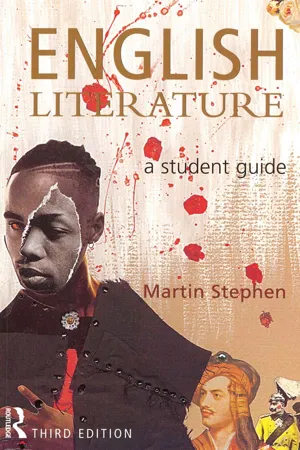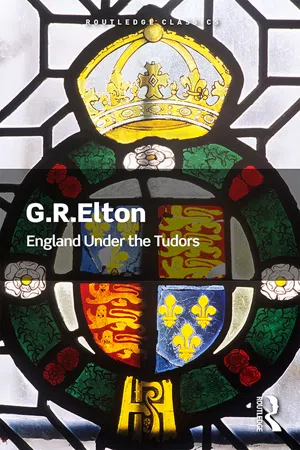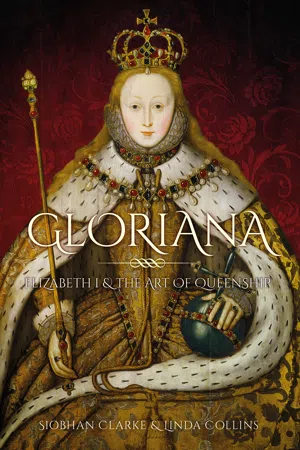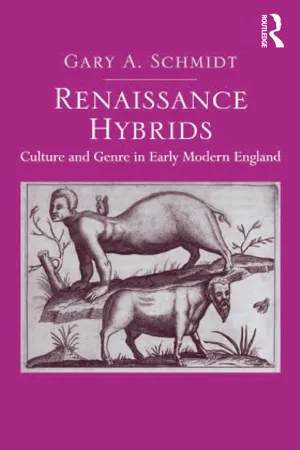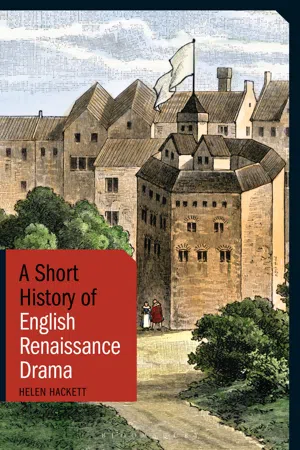Literature
Jacobean Age
The Jacobean Age refers to the period in English history and literature during the reign of King James I (1603-1625). It was a time of significant cultural and artistic achievement, marked by the flourishing of dramatic works, including the plays of William Shakespeare and other renowned playwrights such as Ben Jonson and John Webster. The literature of this era often reflected the social and political complexities of the time.
Written by Perlego with AI-assistance
Related key terms
6 Key excerpts on "Jacobean Age"
- eBook - ePub
English Literature
A Student Guide
- Martin Stephen(Author)
- 2013(Publication Date)
- Routledge(Publisher)
CHAPTER EIGHTElizabethan and Jacobean drama
The literary and historical background
No one has ever really explained why the thirty years from 1580 to 1610 saw one of the greatest flowerings that has ever taken place in English literary history, and probably in the history of world literature. Shakespeare, dealt with in the following chapter, was only part of this literary and dramatic boom, and perhaps not even the most highly thought-of by the age in which he lived. As with any intense flowering of literature, the reasons are historical, political, social, and economic, as well as literary. It is tempting to see a link between great outbursts of creativity in literature and social upheaval. English society in the Jacobean period had to come to terms with the Renaissance (the end of medieval thinking in Europe), the end of Queen Elizabeth I’s reign and the accession of a Scottish King (James VI of Scotland) to the throne of England, as James I, as well as the aftermath of its own battle with the Roman Catholic Church.As far as the Elizabethan and Jacobean period goes the flowering in the theatre was brought to an abrupt end by the English Civil War in 1642, when theatres were closed. They remained closed until 1660 and the restoration of the monarchy under Charles II. However, signs of decadence in the theatre had been visible much earlier than 1642, possibly even as early as 1615; certainly from the mid-1620s drama seemed to have little new to offer.The Theatre
The Elizabethan and Jacobean theatre was the first fully professional theatre in England, in the sense of professional actors performing in purpose-built theatres. There certainly had been acting before, with a religious and a secular input from the medieval mystery, morality, and miracle plays, and wandering troupes of performers putting on acts with no religious content. A favourite place for performing any travelling theatre or entertainment was the yard of an inn. These were often built on three sides of a square, the fourth being open for access by horses and wagons. The inn was a natural meeting point for the locality, could offer accommodation for the players, entertainment for guests, and presumably an increased profit for the innkeeper. By mounting a portable stage at the far end of the inn yard, more expensive seats could be sold for the galleries and rooms that overlooked the yard, whilst cheaper viewing positions could be offered on the floor of the yard itself, at ground level. - eBook - ePub
- Michael Mangan(Author)
- 2014(Publication Date)
- Routledge(Publisher)
Part Two Shakespeare and the Theatre of His TimePassage contains an image
6 Elizabethan and Jacobean tragedyThe great age of English tragedy
Not every age has produced tragedies - or at least, not tragedies that are still read today. Broadly speaking, when we look back over the history of English literature, certain ages seem to have put their best energies into particular literary forms: for the Victorians it was the large-scale realist novel that demanded their greatest effort; for the early eighteenth century it was the urbane satire in verse or prose; for the Romantics it was the contemplative poem. This is not to imply that there were no novels written during the Romantic period, or that the Victorians did not write poetry: we are talking here only about some basic trends and the way in which particular art forms capture the imagination of a culture at particular times. The late sixteenth and early seventeenth century in England was a period when there was a variety of literary activity going on: lyrics, epics, satires, jestbooks, sermons, sonnets, essays all abounded. But it is usual to see this age as the great age of the English drama, and in particular as the great age of English tragedy. It is worth asking why this was so.A relationship may be posited, for example, between the writing of great tragedies in the early years of the seventeenth century and the social and economic conditions which were prevalent in England at the time. This relationship, it should be warned, is not a simple and direct one. Perhaps it would be reassuringly straightforward if it were: if, for example, one could say that the predominance of tragedies in this period were a direct result or expression of a social and economic crisis. Things are rarely that neat in literary history, however. The years we are talking about, from about 1590 through to about 1615 were not devoid of social, political and economic problems, as earlier sections have shown, but the crises of the period were no greater than those of the years immediately before and after this period. The constitutional and ideological upheavals of the mid-sixteenth century and the revolutionary years of the mid-seventeenth were more traumatic than anything that was happening between 1590 and 1615. If anything, it is more realistic to see this period as a comparative lull between the various storms which preceded and followed it. - eBook - ePub
- G.R. Elton(Author)
- 2018(Publication Date)
- Routledge(Publisher)
Cantiones Sacrae , Wilbye at his best, or Dowland’s sad, sweet songs. In the reign of Elizabeth, England reached the highest concentration of musical genius in all her history and led Europe in this field.3. LiteratureAny attempt to summarise here the work of the writers, poets, and dramatists who made of the sixteenth century one of the few really great periods of literature must obviously be hopeless. It was in language and its use that the English Renaissance mainly expressed itself. The visual arts played little part in it; music recorded astonishing achievements but for technical reasons remained a restricted expression of the age; in poetry, on the other hand, no more remarkable work has ever been done. Within the short space of some sixty years, and thanks to the labours of a few men of genius and many men of unusual talent, the English language shed the awkwardness and insufficiency which clung to it and became the flexible and all-competent instrument of an incomparable out-pouring. The greatest of all poets (perhaps in any language) was part of that band, but others beside Shakespeare added their efforts—more than can be listed here. Another difficulty is raised by the fact that the death of Queen Elizabeth marked a date of no importance in this story. There are differences between the Elizabethans and Jacobeans, but the significant years are really 1580–1630. Yet we cannot include here the whole reign of James I. As far as possible we shall therefore confine ourselves to work done before Elizabeth died and to men who were prominent before 1603, taking three subjects in turn—prose, lyrical poetry, and the drama.Prose has always been later to reach perfection than poetry because poetic language is always the first to undergo the discipline of literary treatment. The age of Elizabeth is no exception. Some decent literary prose appeared under Henry VIII, though most of it was cumbersome and long-winded; under the influence of their Greek and Latin studies, Cheke and Ascham wrote a clear if rather pedestrian style; but when the literary men really got hold of prose they did terrible things to it. Dissatisfied with the plainness of daily speech and the artlessness of his predecessors, John Lyly, in his two romances Euphues (1579) and Euphues his England (1580), developed a style of his own which, by the name of Euphuism, became the model and bane of English writing. Its essence lay in a laborious display of rhetorical devices; Lyly was particularly fond of pointless but well-balanced antitheses, frequent alliteration, a prodigality of similes arranged in wearisome strings, and rhetorical questions. Sir Philip Sidney’s Arcadia (c. 1580) suffers from much the same faults, though they are less glaring; oddly enough—in view of the large number of versified romances that ought to have been in prose—the episodic and often exalted Arcadia - eBook - ePub
Gloriana
Elizabeth I and the Art of Queenship
- Linda Collins, Siobhan Clarke(Authors)
- 2022(Publication Date)
- The History Press(Publisher)
7
ELIZABETHAN ARTS: THE GOLDEN AGE
‘AND SHE THE QUEENE OF MUSES IS ’MICHAEL DRAYTONThe Golden Age of Elizabethan arts reached its height in the last decade or so of the Queen’s reign, from the 1590s until her death in 1603, when the English Renaissance fully blossomed. Drama was the dominant art form, attracting an estimated 15,000 people from the growing population of London to attend the theatre each week. Christopher Marlowe was arguably the first great playwright of the era, but after his death in 1593, it was William Shakespeare who dominated the London theatre.The Royal Shakespeare Company consider The Taming of the Shrew to be the dramatist’s earliest play, believed to have been written before 1592. Two Gentlemen of Verona , A Midsummer Night’s Dream and Richard II are examples from the mid-1590s. Hamlet was written around 1600 and All’s Well that Ends Well is thought to span the period between the death of Elizabeth and the coronation of James I. Macbeth (also known as ‘The Scottish Play’) and King Lear are among a large body of work that falls within the Jacobean period.GLORIANA AND THE ELIZABETHAN STAGE
In the early days of Elizabeth’s rule, the morality plays of the medieval era were still being performed, as were stories enacted by strolling players. These were tales written in the vernacular, acted by semi-professional groups, generally in the streets, without scenery and with a minimum of props. But as Elizabeth’s reign progressed, plays became more complex, playhouses opened and the stage of the later Tudor era became accessible to the public on a level that was only rivalled by the Church. Theatregoing became hugely popular with the poorer classes, who somehow found the time and money to go and see plays that today might be considered elitist.The first purpose-built playhouse was the unimaginatively named Theatre, opened in Shoreditch in 1576, followed by the Curtain a year later. By 1587 the Rose, known for its connections with Christopher Marlowe, had been built beside the Thames in Southwark. In 1572, players were defined as vagabonds and criminals who were subject to arrest, whipping or branding. Religious and civic authorities condemned the playhouses as a scandal and an outrage. To avoid prosecution, theatres clustered around the Southwark area, which was known as a ‘liberty’. In other words, it was outside the city boundaries, beyond the control of the Lord Mayor, and a part of London where all sorts of prohibited activities could take place openly. The original Globe Theatre opened in Southwark in 1599, to house a group of players known as the Lord Chamberlain’s Men. They were a company of six actors who each took shares in the theatre to fund its construction. The young William Shakespeare was a member and wrote most of their plays. His genius for wordplay and dramatic dialogue was unprecedented. - eBook - ePub
Renaissance Hybrids
Culture and Genre in Early Modern England
- Gary A. Schmidt(Author)
- 2016(Publication Date)
- Routledge(Publisher)
Chapter 5Jacobean Absolutism and the Rise of TragicomedyCrisis and Compromise
In 1616 the poet-sovereign King James I of England published his collected Workes ; in the same year, the esteemed jurist Sir Edward Coke was dismissed from the King’s Bench and the Privy Council for repeatedly invoking common law to hedge the King’s absolute power. In 1616, finally, the great Royalist poet and author of Jacobean masques, Ben Jonson, published his own Works ; the frontispiece of this audacious volume featured the figure of Tragicomoedia at the top of a Romanesque architectural façade, standing above (and therefore superior to) the lower figures of Satyr, Pastor, and the muses of Tragoedia and Comoedia.1 Linking these three contemporary events may at first seem a rather aimless exercise in ‘connect the dots’; however, as I shall argue here, the rise of tragicomedy in the early Stuart period owes its force and relevance to the political developments, philosophy, and contestations of the period. Tragicomedy emerged in the early years of James’s reign, in part, to mediate between the demands of the King’s absolutist philosophy and a society that had increasingly to account for the emerging interests of the landed gentry and radical groups such as the Puritans and Levellers.From the conservatism of the court masque to the festive misrule of city comedy, Jacobean literary genres consciously attempted to register and adapt to new social reorganizations and contemporary political developments. The pastoral tragicomedy inaugurated by Giambattista Guarini, in particular, emerged in its English incarnation as an ideal vehicle for such considerations. Franco Moretti maintains, for example, that ‘the ‘mixed’ form of tragicomedy embodies in its dramatic structure that compromise between the sphere of the state and civil society that was one of the great Elizabethan aspirations’ (61). Moretti emphasizes the essential conservatism of tragicomedy, seen in works that stage the monarch’s ability to effect an ‘organic restoration of hierarchy and meaning’ by satisfying nostalgia for a feudal worldview in which ‘man is what his sovereign makes him’ (67, 60).2 - eBook - ePub
- Helen Hackett(Author)
- 2012(Publication Date)
- I.B. Tauris(Publisher)
c. 1585–1603) and the Jacobean period (1603–25) since these produced most of the Renaissance plays that are well known today. Its aims are threefold: to convey the variety and richness of English Renaissance drama; to explore why and how this period produced this creative explosion; and to suggest why these plays continue to have such hold upon readers and audiences in the modern world.WHAT WAS THE RENAISSANCE?At the outset it is worth pausing to consider what we mean by the term ‘Renaissance’. Literally it means ‘rebirth’, and the Oxford English Dictionary defines it as ‘the revival of the arts and high culture under the influence of classical models, which began in Italy in the fourteenth century and spread throughout most of Europe by the end of the sixteenth.’6 It took a little time for these developments to reach England, and therefore the English Renaissance is usually regarded as having taken place in the sixteenth and seventeenth centuries. In English drama, the period of greatest activity and artistic achievement was from the late 1580s to the 1620s, covering the last part of the Elizabethan period (Elizabeth I reigned from 1558 to 1603) and the Jacobean period (the reign of James I, 1603–25).Fifteenth-century Italy saw an artistic and intellectual flowering which many of its participants regarded self-consciously as a movement of renewal and of the rediscovery of the classical arts and scholarship that had fallen into decay in the middle ages. Classicism became associated with purity, naturalism, and clarity, as opposed to the supposed gothic barbarity of intervening centuries. This attitude was crystallized in the term rinascita , or rebirth, first used by the Italian artist and critic Giorgio Vasari (1511–74) in his book The Lives of the Artists (1550) to describe how Italian painters and sculptors of the fourteenth to sixteenth centuries had revived classical style and techniques. The general use of the term ‘Renaissance’ in cultural history began later, with The Civilization of the Renaissance in Italy (1860) by the Swiss author Jacob Burckhardt (1818–97). For Burckhardt the cultural advances of Italy in the fourteenth to sixteenth centuries were dependent upon the existence of competing independent city states ruled by despotic dynasties, who deployed artistic patronage as a means of celebrating and promoting their power. In this culture, despots and artists alike personified the triumph of the self-interested human will: ‘Despotism . . . fostered in the highest degree the individuality not only of the tyrant or condottiere himself, but also the men whom he protected or used as his tools.’ Burckhardt takes as an example Leon Battista Alberti (1404–72), an author, artist, and architect: ‘an iron will pervaded and sustained his whole personality; like all the great men of the Renaissance, he said, “Men can do all things if they will.”’ In his mastery of a wide and diverse range of intellectual interests Alberti also exemplified Burckhardt’s idea of the Renaissance man, ‘the “all-sided man” – l’uomo universale ’.7
Index pages curate the most relevant extracts from our library of academic textbooks. They’ve been created using an in-house natural language model (NLM), each adding context and meaning to key research topics.
